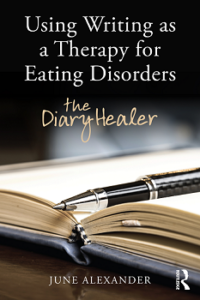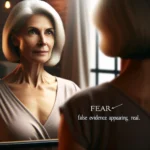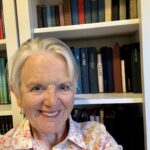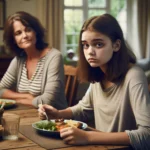Securing trust when writing a non-fiction story – feeling safe enough to share innermost thoughts and feelings
Securing trust when writing a non-fiction story – feeling safe enough to share innermost thoughts and feelings

By June Alexander
Securing of trust is essential when recovering from an eating disorder, and likewise it is essential when we are writing stories about the illness. Today I will describe the ways in which trust was integral to the writing of my book Using Writing as a Therapy for Eating Disorders – The Diary Healer. My belief in the need for this book, the creative work in my PhD, had led to a publishing contract and a cohort of research participants willing to entrust me with excerpts from their personal diaries, which until now had been kept strictly private. But this early indication of trust also needed to be nurtured and maintained throughout the project.
Trust was intrinsic to my relationship with the research participants, and in developing a narrative to inspire trust in readers. I needed to help the research participants (all of whom had experienced an eating disorder) to feel sufficiently included, safe and respected to confidently share and reveal their innermost thoughts and feelings. Clarity in what the diarists could expect in return for sharing their deeply private material with me, for example, was crucial.
My consistent message was that there was no certainty that their excerpts would be included in the book; however, every contribution nevertheless would be considered and would contribute to the overall research. To offset possible disappointment, participants were invited to be included under their own name or pseudonym in the book’s acknowledgement list. Securing trust with each diarist was an important element in my project’s aim of reaching a target audience that comprised people who had experienced or were experiencing an eating disorder, and also those people who had eating disorder symptoms and had yet to access health services.
Primarily for the ethical reason of providing identity protection, and to maintain an open line of communication, an email address was the sole form of contact with each research participant. Without opportunity for face-to-face meetings, the development of an intimate level of trust required patience, empathy and understanding, to counter the known illness characteristics such as high sensitivity and difficulty in trusting others. While I needed the participants to trust me, I also needed to trust them. This bond of trust was reciprocated and strengthened through the sharing process. We were all diarists with experience of an eating disorder who felt sufficiently secure to share deeply private material, and feelings of connection and belonging were strengthened through this mutual sharing of the illness experience. Diarists reported that their contribution to this book and research was providing them with a sense of self-worth and making their life count.
“[T]hank you for the opportunity to share my story, … and for giving me a voice that I have not had before and validating what I have been through to get where I am.” – Ruby (p. 236-237)
Trust was procured through shared experiences. At all times, I was mindful of my research participants’ distinctive vulnerabilities. I respected their right to withdraw from the project at any time, and emphasized that their well-being was highest priority. I nurtured their faith through identifying with their healing journey and through regular communication on the sometime complex processes in creating The Diary Healer, and by responding promptly to any query or indication of illness lapse.
Besides establishing a connection with the research participants, the development of a sense of trust with future readers was imperative for The Diary Healer to accomplish its aim of assisting people with eating disorders. Making the diarists the main voice in the first section in The Diary Healer was a technique undertaken to encourage trust among readers, by helping them to identify and engage with the content. The data gathering and melding processes had involved determining which diary entries of others and mine to publish — and to what extent.
Besides trusting my research participants, I had to trust myself. I had to trust my judgment in imposing limits on which and how much of my own voluminous entries to use, and make choices and set limits on which of my participants’ entries to use, as did they in the first instance, in deciding what excerpts from their diaries to share with me. I needed to be mindful to not trust that the reader was as familiar as me or others cited in the book with the (a) the depths of hell offered by a severe, chronic eating disorder; (b) the challenges and ambivalent feelings associated with recovery; and (c) the rich and complex joys attendant to recovery.
The research participants were continuing to live their daily lives during the two-and-a-half years of the book creation process and were subject to both psychological and psychosocial challenges at vulnerable times. Several diarists relapsed and required hospital admissions. This posed the risk that they might experience anxiety and shame in revealing this setback in to their healing process.
There was also a risk that the reflection required in reading and sourcing excerpts from diaries, which had been written during a time of extreme mental and emotional duress, might trigger painful feelings and cause discomfort in the participant. These risks were reduced by establishing an early, strong bond of trust and respect between each participant and myself, so they felt at ease in sharing concerns and in seeking reassurance and clarification. Trust was nurtured and maintained through the rigor of providing: empathy, respect and understanding; regular communication; prompt respond to every email; no pressure – participation was voluntary; collaborative decision-making; careful wording of every item of correspondence; encouragement of sharing with therapist/treatment team if any sign of ‘triggering’ occurred; and transparency at all times.
Sharing my story had helped to secure a firm base of trust. Research participants stated they felt connected and confidence in sharing their story, “because you have been there too; I know you understand.” All 70 research participants remained involved in my project for its duration. At the outset, the participants stated they wanted to contribute data for the research because sharing their story would help them feel their life counted. At the conclusion of the project they noted the process of reflection had led to an extra benefit, that of more clearly seeing their illness in context of their life experience.
For further information, see Using Writing as a Therapy for Eating Disorders – The Diary Healer.






